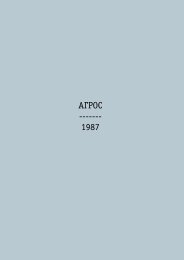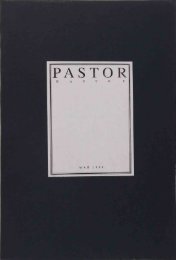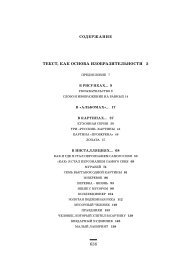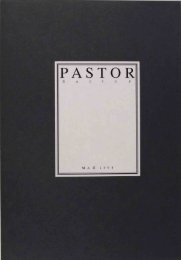Времена наступали другие, и КГБ, думаю, уже готовился к Перестройке.Это были мои первые работы, обращённые непос-редственно кязыку, методам и традициям круга МАНИ. Видимо, они постепенноперерасли в издательскую и архивную деятельность девяностыхгодов, когда я уже стал работать за границей.С конца же семидесятых моё поколение только начинало подниматьсяна должный профессиональный уровень: тогда появилисьгруппа Мухомор (Константин Звездочётов, Свен Гундлах, Сергей иВладимир Мироненко), Юрий Альберт, Надежда Столповская, чутьпозже Андрей Филиппов. С начала восьмидесятых начали появлятьсяталантливые художники из Одессы: Сергей Ануфриев, ЮрийЛейдерман, Лариса Резун, группа Перцы. Художники же старшегопоколения – Илья Кабаков, Виктор Пивоваров, Комар и Меламид(успевшие даже эмигрировать в 77 году в Америку), Эрик Булатов,Олег Васильев, Иван Чуйков, Франциско Инфантэ, группы Коллективныедействия и Гнездо (Донской, Рошаль, Скерсис), названнаятак на Западе за одноимённую работу на скандальной выставке наВДНХ, и многие другие замечательные художники работали уже вполную силу.Однако рынка на современное искусство не было. Стоимостьработ даже старшего поколения, думаю, не превышала две-три средниемесячные зарплаты. Покупали в основном дипломаты, естественно,цены каждый раз были договорными. Моя месячная зарплатасторожа рав-нялась 72 рублям, позже, когда я работал художественнымредактором в издательстве Мир, – 120 рублям. Вопроспродажи у моего поколения до Перестройки не стоял. Точнее,устраивались, кажется, пару раз квартирные аукционы. К примеру,отъезду Никиты Алексеева в Париж предшествовал в 1986 году аукционв мастерской на Фурманном. На этом аукционе я купил двеработы: Ностальгия и Краткая история современного искусства, илижизнь и смерть Чёрного квадрата. Размер работы 100х3670см. Я заплатилза неё “колоссальную сумму” в 50 рублей (соотнесите с зарплатой).После аукциона ко мне подошел растерянный Никита и сказал:“Ты с ума сошел, я бы тебе её так подарил”. Работу КонстантинаЗвездочётова “Istr… ” я купил, кажется, за 25 рублей, зато все остальные,на мой взгляд, лучшие его работы я получил в подарок -Шелкография, Пролетарии на паровоз, Предатель Горького, Голубые уChuikov, Francisco Infante, and those associated with thegroups Kollektivnye deistviia (K/D; Collective Actions) andGnezdo (Nest). The latter took its name from a scandalouswork at VDNKh in which the three artist members of the group“hatched” an egg in a giant nest. Many other wonderful artistswere already working at full force at that time.However, there was no market for contemporary art. Eventhe value of works by artists of the older generation did not, Ibelieve, exceed two or three average monthly paychecks.Most of the buyers were diplomats, and in every instance theprices were negotiated. My monthly salary as a night watchmanwas seventy-two rubles, but later, when I worked as anart editor at the publishing house Mir, it was one hundred andtwenty rubles. Prior to perestroika there was no question ofthe artists of my generation selling our work. I recall that in themid- to late 1980s, there were several auctions organized inprivate apartments. For example, in 1986, before NikitaAlekseev left for Paris, there was an auction in the studio onFurmanny Lane. I bought two works at the auction, includingAlekseev’s Short History of Contemporary Art, or the Life andDeath of the Black Square, a work exhibited at theKupferstichkabinett in Berlin in 2003. The work is 1 x 36.7meters, and I purchased it for it the “colossal sum” (relative tomy salary) of fifty rubles. After the auction, an embarrassedNikita came up to me and said, “You’ve lost your mind; I wouldhave just given it to you.” I bought Konstantin Zvezdochetov’swork Istr…, for, I believe, twenty-five rubles, but the rest and, Ibelieve, the best of his works I received as a gift: Silkography,Proletarians to the Steam Engine, Gorky’s Betrayer, Gaysnear the Bolshoi.In every case Kostya would squint his eyes and say,“Maybe I’ll take a ruble off.” But one time he said, “Do you likeit? It’s yours!” In fact you could say that the bulk of my collectionis based on gifts. I was also given works because it wasknown that this was the first collection of our generationassembled by an artist. This is how it came to be that a timebomb was placed under the artist Vadim Zakharov. The collectionand the Archive began to acquire strength – slowly butsurely nailing the artist’s feet to the floor.Gradually “I-collector” rose to the level of “I-artist.”Collecting soon turned into a mania. I began to collect as aprofessional. I selected, asked, and bought (no matter theamount).
Большого театра. Каждый раз Костя прищурясь говорил: “Можетрублик скинуть”. А в другой раз: “Нравится? Дарю!” Вобщем, всюмою коллекцию можно назвать дарственной. Дарили мне работы ипотому, что знали – это первая коллекция нашего поколения, собираемаяхудожником. Но таким образом и была заложена бомбазамедленного действия под художника Вадима Захарова. Коллекцияи Архив быстро набирали силу, медленно, но уверенно прибиваяноги художника к полу.Постепенно “я-коллекционер” стал на уровень “я-худож-ник”.Собирание стало превращаться в манию. Я начал собирать коллекциюпрофессионально. Я выбирал. Просил. Покупал (не важно засколько). И всегда удивлялся, почему люди с деньгами, а тогда тожебыли люди с кошельком, не брали хотя бы даром то, что вне всякогосомнения отражало важный этап развития московской сцены. Вконце восьмидесятых Андрей Ройтер и Сергей Волков подарилимне несколько своих живописных работ. Юрий Лейдерман, послепервой выставки в Клубе авангардистов, снял со стены и подарил двебольшие серии - Феленидка и Лукьянчик. А работы группы Чемпионымира, появившейся на заре Перестройки, были мной “куплены” зацены, которые даже не удобно здесь назвать.Собирали художники, других инстанций не было. У многих хранилисьуникальные работы, тексты, объекты. Собирание и архивированиестало одной из характерных черт того времени. Недаром вназвании Папки МАНИ (<strong>Московский</strong> архив нового искусства, 1980-1982гг.), а позже и в неофициальном названии “Художники группыМАНИ” акцент был поставлен на Архив, а не на манифест. Архивпобедил. (Не в этом ли одна из проблем современ-ного русскогоискусства?!)В этом пункте можно перебросить мостик от Архива к Изданиям.Папки МАНИ стали первыми важными коллективными изданиями,несмотря на тираж в 5 экземпляров. Метод распространения былпримитивно простознакомившись с материалом, один художникпередавал папку другому. В этом уникальном издании приняли участиелучшие художники и поэты московского андерграунда.Инициатором его был Андрей Монастырский. Позже Андрей продолжилиздание, но уже под другим названием Сборники МАНИ.Здесь он уже был единоличным редактором, задававшим тон каждомувыпуску. Важно и то, что очень многие московские художникиAnd I was always surprised why people with money – and atthat time there were people of means – didn’t even take forfree work that undoubtedly reflected an important stage in thedevelopment of the Moscow art scene. In the late 1980s AndreiRoiter and Sergei Volkov gave me some of their paintings. YuriLeiderman, after the first exhibition at the Club of the Avant-Gardists in 1987, gave me two large series featured in theshow: Felendika and Luk’ianchik. And I “bought” works fromChampions of the World, a group that had emerged at thedawn of perestroika, for an amount that I am too embarrassedto quote here.Artists were the ones who did the collecting – there wereno other channels or institutions. Many acquired unique works,texts, and objects. Collecting and archiving became one of thehallmarks of the time. It’s no coincidence that in the name“MANI Papki” (MANI Folios) and later in the unofficial designation“Artists of the MANI Circle” the emphasis was placed onthe Archive, and not on the proclamation. The Archive was victorious.(Isn’t this one of the problems of contemporary Russianart?!)As far as this point is concerned we can build a bridge fromthe Archive to the Publications. The MANI Folios became thefirst important collective publication of the MoscowConceptualists despite a run of only five copies. The distributionprocess was primitively simple: after an artist pored over thematerials he handed the folio to another artist. The best artistsand poets of the Moscow underground took part in this uniqueendeavor. Andrei Monastyrsky spearheaded the publication,later continuing it under a different name: the MANI Collection.Here, he was the sole editor, setting the tone for every issue.It’s also important to note that many Moscow artists made theirliving working in publishing houses, illustrating and designingbooks, and at the same time, utilizing book design methods intheir own works. Incidentally, the third issue of the journalPastor is dedicated to this subject.Another artist-launched initiative was the “MANI Museum.”Founded in 1988 by Nikolai Panitkov, the MANI Museum gatheredmajor works by artists of various generations. All theworks that entered the museum collection, shown at theCarmelite Monastery in Frankfurt in 1991, were donated by theartists themselves. It was this collection that prompted artists tostart collecting works by their fellow artists in the first place.
- Page 2 and 3: ЕЖЕГОДНЫЙ МЕЖДУНАР
- Page 5: Объекты радикально
- Page 11 and 12: мы, её динамики, её
- Page 13 and 14: является архивом, а
- Page 15 and 16: Автопортрет с завя
- Page 17 and 18: Кабачок/ Kabachok (Marrow Sq
- Page 19 and 20: Портрет В. Захарова
- Page 21 and 22: Потерянный день/ Lost
- Page 23 and 24: Краткая история со
- Page 25 and 26: Краткая история со
- Page 27 and 28: 1. Трещины на стене.2
- Page 29 and 30: 1. Магнитофон «Grundig»
- Page 31 and 32: 1. Саксофон, выданны
- Page 33 and 34: 1. Сломанный электр
- Page 35 and 36: 1. Бонги, принесенны
- Page 37 and 38: 1. «Наш флаг», изгот
- Page 39 and 40: Портрет Монастырск
- Page 41 and 42: В 1986 г. Герман Виног
- Page 43 and 44: Художники! Прошу не
- Page 45 and 46: Рисунок к изданию П
- Page 47 and 48: Сирень/ Lilac, 1987СЕРГЕ
- Page 49 and 50: Без названия/ Untitled,
- Page 51 and 52: Шпиц/ Spitz, 1988
- Page 53 and 54: АНАТОЛИЙ ЖУРАВЛЕВAN
- Page 55 and 56: Я никогда ничего не
- Page 57 and 58:
Пролетарии, на пара
- Page 59 and 60:
Рисунок к изданию П
- Page 61 and 62:
Филенидка/ Filenidka, 1985
- Page 63 and 64:
Лукъянчик/ Lukjanchik, 198
- Page 65 and 66:
Труп отца!/ Father's Corpse
- Page 67 and 68:
Мне с нею познакоми
- Page 69 and 70:
Моя бабушка .../My Grandm
- Page 71 and 72:
ЕЛЕНА ЕЛАГИНАELENA ELAG
- Page 73 and 74:
Вредители/ Pests, 1999
- Page 75 and 76:
Спальный мешок из с
- Page 77 and 78:
Кережка и волокуша
- Page 79 and 80:
Исход/ Exodus, 1976, 1983ИГ
- Page 86 and 87:
Серию Выбор цели я
- Page 89 and 90:
Лозунг КД (Коллекти
- Page 91 and 92:
Made in Slum/ Made in Slum, 2007
- Page 93 and 94:
АНДРЕЙ МОНАСТЫРСКИ
- Page 95 and 96:
Посвящение Вадиму
- Page 97 and 98:
Смерть мухам / Death to
- Page 99 and 100:
Глубокая задумчиво
- Page 101 and 102:
ВЛАДИМИР НЕМУХИНVLAD
- Page 103 and 104:
Валет. Из серии рис
- Page 105 and 106:
ПАВЕЛ ПЕППЕРШТЕЙНPA
- Page 107 and 108:
Динарий Кесаря/ Cesar
- Page 109 and 110:
Поединок Номы и Сов
- Page 111 and 112:
ВИКТОР ПИВОВАРОВVIKT
- Page 113 and 114:
Донесение о состоя
- Page 115 and 116:
ДМИТРИЙ ПРИГОВDMITRI P
- Page 117 and 118:
Рисунок к изданию П
- Page 119 and 120:
Без названия/ Untitled,
- Page 121 and 122:
Артек/ Artek, 1989
- Page 123 and 124:
АНДРЕЙ РОЙТЕРANDREI ROI
- Page 125 and 126:
ВИКТОР СКЕРСИСVIKTOR S
- Page 127 and 128:
Модель искусства /Th
- Page 129 and 130:
Музыкальные инстру
- Page 131 and 132:
Машина Юстиции / Machi
- Page 133 and 134:
Лес / The Forest, 1985
- Page 135 and 136:
АНДРЕЙ ФИЛИППОВANDREI
- Page 137 and 138:
Приглашение на ужи
- Page 139 and 140:
ЧЕМПИОНЫ МИРАГиа А
- Page 141 and 142:
Таймс / The Times, 1986
- Page 143 and 144:
Эта работа первона
- Page 145 and 146:
Рисунок к изданию П
- Page 147 and 148:
Без названия (Лодки
- Page 149 and 150:
Серия рисунков, соб
- Page 151 and 152:
До р о т е я Цв и р н
- Page 153 and 154:
актуальные проблем
- Page 155 and 156:
время важных мероп
- Page 157 and 158:
Пастор Nr.1 - Имена / Pa
- Page 159 and 160:
Никита Алексеев, Юр
- Page 161 and 162:
Иллюстрации к Детс
- Page 163 and 164:
В ос но ву из да ния
- Page 165 and 166:
Достаточно легкого
- Page 167 and 168:
Вла д и м и р На у м е
- Page 169 and 170:
For the sake of simplicity a diagra
















